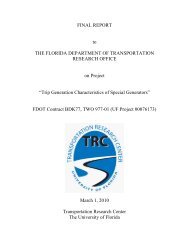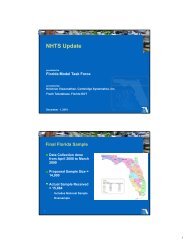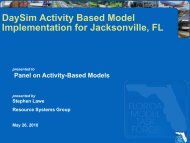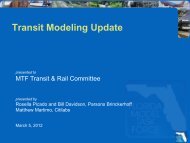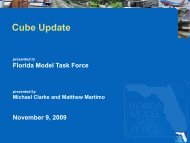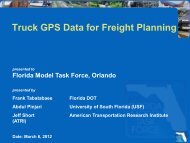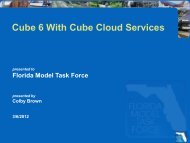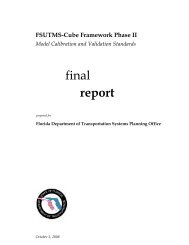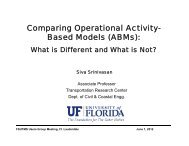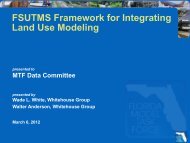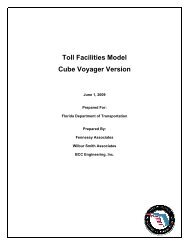ATA Subcommittee Presentation - FSUTMSOnline
ATA Subcommittee Presentation - FSUTMSOnline
ATA Subcommittee Presentation - FSUTMSOnline
Create successful ePaper yourself
Turn your PDF publications into a flip-book with our unique Google optimized e-Paper software.
November 7, 2011<br />
1
• Goals/Mission statement<br />
• Dynamic Traffic Assignment (DTA) <strong>Subcommittee</strong><br />
created by the MTF in May, 2010<br />
• Merger of DTA and Toll Modeling <strong>Subcommittee</strong>s;<br />
Advanced Traffic Assignment<br />
Sub-committee formed in October, 2011<br />
• <strong>ATA</strong> webpage<br />
2
By Neelam Fatima<br />
<strong>ATA</strong> Sub-Committee Chair<br />
3
• Workshop/Survey<br />
• Development of the requirements (testing<br />
criteria)<br />
• Testing based on selected networks<br />
• Running the network in Static and dynamic<br />
environments<br />
• Development of ISSTA tool<br />
• Started calibration of I-95 network<br />
• Time line<br />
4
A. Hypothetical Networks<br />
B. Jacksonville Regional Network<br />
C. I-95 between Golden Glades and SR 836<br />
with Parallel Arterial Sub-area Network in<br />
Miami-Dade County<br />
5
• Selected by the DTA Sub-committee<br />
• Extracted from Statewide Model<br />
• 151 sq. mile<br />
• 1294 number of nodes<br />
• 2805 number of links<br />
• 143 number of zones<br />
• Running time of Static Assignment VS<br />
Dynamic Assignment (Cube Avenue, Transim<br />
and DynusT)<br />
6
• Static Model SERPM 7.0<br />
• 29 sq. mile<br />
• 1193 number of nodes<br />
• 2573 number of links<br />
• 247 number of zones<br />
• Comparison of run time but also used as case<br />
study in the use of ISSTA and calibration<br />
7
• General Hardware<br />
• General Software<br />
• Shortest Path and Path Choice<br />
• Traffic Flow Model<br />
• Network Demand Specification<br />
• Modeling of Advanced Strategies<br />
• Transit Modeling<br />
8
• Static Environments<br />
• Cube Voyager<br />
• Dynamic Environments<br />
• Cube Avenue<br />
• Transims<br />
• DynusT<br />
9
• Signal control modeling<br />
• Traffic measures<br />
• TAZ representation for DTA modeling<br />
• Fine grained OD estimation<br />
• Calibration<br />
• Convergence<br />
• Running Time<br />
10
13<br />
ITS Modeling and Dynamic Traffic Assignment<br />
By<br />
Mohammed Hadi, Ph.D., PE<br />
Florida International University<br />
Presented at the Advanced Traffic Assignment Meeting<br />
November 7, 2011
14<br />
Background<br />
• Need to assess the benefits and costs of ITS for<br />
operations and planning in Florida<br />
• FITSEVAL developed in 2007-2008<br />
• Funded by FDOT Research Center<br />
• A joint FDOT System Planning Office and FDOT ITS Section<br />
effort<br />
• Based on static assignment and analytical models<br />
• Being extended to include DTA and analysis based on<br />
real-world data
15<br />
FITSEVAL Overview<br />
• A tool developed as part of the FSUTMS environment<br />
• FSUTMS is the approved demand modeling environment in Florida<br />
• No need for file conversion<br />
• Use calibrated regional models<br />
• Flexible and extendable evaluation environment<br />
• Up-to-date methods and parameters<br />
• Powerful data management, modeling, and interfaces
16<br />
FITSEVAL Utilization<br />
• FITSEVAL can support FDOT and MPO decisions<br />
• Benefits of ITS versus other alternatives such as geometry<br />
improvements as part of the long range and short range plans<br />
• It can also be used to assess ITS agency operation benefits<br />
• The original FITSEVAL is a sketch planning evaluation<br />
tool but has some advanced modeling capabilities<br />
• For example it utilizes queuing theory and allow the users to<br />
enter the incident management attributes in the region<br />
• More detailed operational and data analysis being<br />
introduced for design and operation purposes
17<br />
Evaluated ITS Deployment<br />
• Ramp Metering<br />
• Incident Management Systems<br />
• Highway Advisory Radio (HAR) and Dynamic Message Signs (DMS)<br />
• Advanced Travel Information Systems<br />
• Managed Lanes (HOT and tool lanes)<br />
• Smart Work Zones<br />
• Road Weather Information Systems<br />
• Signal Control<br />
• Transit Vehicle Signal Priority<br />
• Emergency Vehicle Signal Priority<br />
• Monitoring and Management of Fixed Route Transit<br />
• Transit Information Systems<br />
• Transit Security Systems<br />
• Transit Electronic Payment Systems
18<br />
Performance Measures<br />
• Vehicle miles of travel (VMT)<br />
• Vehicle hours of travel (VHT)<br />
• Average speed<br />
• Number of accidents<br />
• Fatality<br />
• Injury<br />
• Property damage only<br />
• Fuel consumption (gallons)<br />
• Monetary benefits to users and/or agency, as appropriate<br />
• Emission (gm)<br />
• Hydrocarbon<br />
• Carbon monoxide<br />
• Oxides of nitrogen
19<br />
Evaluation Methods<br />
• A method developed for each component based on<br />
review and assessment of methods used in the past<br />
• Default ITS impact parameters derived based on a<br />
review of previous evaluation studies, USDOT benefit<br />
database and the values used in existing ITS planning<br />
tools<br />
• Costs were obtained based on surveys of agencies in<br />
Florida<br />
• The user can change the default ITS impact<br />
parameters and perform sensitivity analysis
User Interface<br />
20
Visualization of Performance<br />
21
22<br />
Original Development Status<br />
• Project completed in December 2008<br />
• <strong>Presentation</strong>s, webinars, and four day workshop<br />
completed. A second workshop planned for 2012<br />
• Integrated with the SERPM model – the largest model<br />
in Florida<br />
• Integration with other regional models is being<br />
automated by FDOT
23<br />
Recent Application<br />
• FDOT D4 required B/C analysis for information<br />
sharing with FHP and arterial DMS<br />
• Other components of FDOT D4 had already been evaluated<br />
• The two components were not originally coded in<br />
FITSEVAL<br />
• The tool was easily modified to allow the evaluation<br />
• Additional information of the use of information was gathered<br />
from FHP<br />
• The tool allowed very effective and efficient evaluation
24<br />
Extended FITSEVAL<br />
• On-going effort<br />
• Utilization of archived data combined with<br />
simulation/DTA to estimate the performance of the<br />
transportation systems with and without ITS<br />
• Extension initially only applied Freeway ITS modules<br />
• Inclusion of EPA MOVE model parameters for environmental<br />
impact estimations<br />
• Expected completion: Summer 2012
25<br />
Data Capture Tool<br />
• ITSDCAP – ITS Data Capture and Performance<br />
Management Tool<br />
• Capture, archive, and analyze data from multiple sources<br />
• Provide support of FITSEVAL and model calibration and<br />
validation<br />
• Estimate parameters based on ITS data<br />
• Incident management parameters<br />
• Managed lane parameters<br />
• Ramp metering benefits<br />
• Work zone and weather impacts<br />
• DMS benefits
26<br />
Data from Multiple Sources<br />
• SunGuide data (TSS, TVT data, incident, DMS, etc.)<br />
• Central data warehouse<br />
• Statistics office data<br />
• Weather data D4 RWIS, road weather agencies<br />
• Managed lane dynamic congestion pricing rates<br />
• Work zones<br />
• Crash data/CAR System<br />
• 511 data
27<br />
DTA/Simulation Support<br />
• Currently investigating replacing static assignment<br />
with Dynamic Traffic assignment in some ITS<br />
applications<br />
• Allows more detailed analysis and decision support of<br />
traffic operations
28<br />
ITSDCAP<br />
Data (Future)<br />
· Transit<br />
· Arterial<br />
· IntelliDrive<br />
· Private Sector Data<br />
Evaluated ITS and<br />
Benefit-Cost<br />
Enhanced<br />
FITSEVAL<br />
Traffic Models<br />
Demand<br />
· Macro<br />
· Meso<br />
· Micro<br />
Data (Current Project)<br />
· ITS Traffic Detectors<br />
· Statistic Office<br />
· Pricing Data<br />
· Work Zone Data<br />
· Events<br />
· Weather<br />
· Incident Data<br />
· Crash Data<br />
· DMS/HAR Activation<br />
· 511 Data<br />
· RCI Data<br />
ITSDCAP<br />
FITSEVAL<br />
Support<br />
Data<br />
Capture<br />
DSS<br />
Support<br />
Traffic Modelling<br />
Support<br />
Visulization<br />
Performance<br />
Measures<br />
· Delay<br />
· Travel Time<br />
· Travel Time Reliability<br />
· Safety<br />
· Environment<br />
· Others<br />
Strategies<br />
· Toll Lane<br />
· Incident Management<br />
· Traveler Information<br />
· Smart Workzone<br />
· Ramp Metering<br />
· RWIS<br />
· Special Events<br />
· Future<br />
- Transit<br />
- Arterial<br />
- IntelliDrive<br />
Data<br />
Fusion<br />
Performance<br />
Measurements<br />
Strategy Assessment<br />
and<br />
Recommendations<br />
Standard<br />
Location<br />
Referencing<br />
Future Decision<br />
Support Tools<br />
Existing Products<br />
· MOVE<br />
· SSAM<br />
· SHRP2<br />
· Safety Analyst<br />
· IHSDM
Questions/Comments<br />
29



